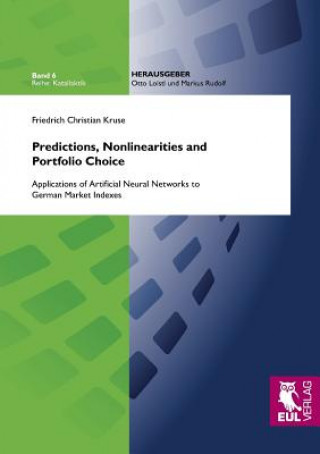
Code: 08928015
Predictions, Nonlinearities and Portfolio Choice
by Friedrich Christian Kruse
Finance researchers and asset management practitioners put a lot of effort into the question of optimal asset allocation. With this respect, a lot of research has been conducted on portfolio decision making as well as quantitative ... more
- Language:
 English
English - Binding: Paperback
- Number of pages: 220
Publisher: Josef Eul Verlag Gmbh, 2012
- More about this

77.87 €
RRP: 79.51 €
You save 1.64 €

In stock at our supplier
Shipping in 15 - 20 days
You might also like
-

Trumpet-Major
23.57 € -

Ladder
22.16 € -

Miracle Mongers and Their Methods
19.54 € -

Grigori, El Caido
48.96 € -

Management Education for Global Sustainability
90.07 € -

Challenges in Volunteer Management
65.88 € -

Robert Burns. Les Oeuvres (Ed.1893)
33.24 €
Give this book as a present today
- Order book and choose Gift Order.
- We will send you book gift voucher at once. You can give it out to anyone.
- Book will be send to donee, nothing more to care about.
More about Predictions, Nonlinearities and Portfolio Choice
You get 196 loyalty points
 Book synopsis
Book synopsis
Finance researchers and asset management practitioners put a lot of effort into the question of optimal asset allocation. With this respect, a lot of research has been conducted on portfolio decision making as well as quantitative modeling and prediction models. This study brings together three fields of research, which are usually analyzed in an isolated manner in the literature:- Predictability of asset returns and their covariance matrix- Optimal portfolio decision making- Nonlinear modeling, performed by artificial neural networks, and their impact on predictions as well as optimal portfolio constructionIncluding predictability in asset allocation is the focus of this work and it pays special attention to issues related to nonlinearities. The contribution of this study to the portfolio choice literature is twofold. First, motivated by the evidence of linear predictability, the impact of nonlinear predictions on portfolio performances is analyzed. Predictions are empirically performed for an investor who invests in equities (represented by the DAX index), bonds (represented by the REXP index) and a risk-free rate. Second, a solution to the dynamic programming problem for intertemporal portfolio choice is presented. The method is based on functional approximations of the investor's value function with artificial neural networks. The method is easily capable of handling multiple state variables. Hence, the effect of adding predictive parameters to the state space is the focus of analysis as well as the impacts of estimation biases and the view of a Bayesian investor on intertemporal portfolio choice. One important empirical result shows that residual correlation among state variables have an impact on intertemporal portfolio decision making.
 Book details
Book details
Book category Books in English Economics, finance, business & management Business & management
77.87 €
- Full title: Predictions, Nonlinearities and Portfolio Choice
- Author: Friedrich Christian Kruse
- Language:
 English
English - Binding: Paperback
- Number of pages: 220
- EAN: 9783844101850
- ISBN: 9783844101850
- ID: 08928015
- Publisher: Josef Eul Verlag Gmbh
- Weight: 268 g
- Dimensions: 210 × 148 × 12 mm
- Date of publishing: 13. September 2012
Trending among others
-

The Personal MBA 10th Anniversary Edition
31.43 € -

Personal MBA
14.30 € -22 % -

The Hard Thing about Hard Things
23.47 € -18 % -

Market Leader 3rd Edition Intermediate Coursebook & DVD-Rom Pack
34.15 € -6 % -

Slight Edge
16.72 € -19 % -

Secrets of Power Negotiating - 25th Anniversary Edition
22.76 € -4 % -

Good To Great
22.46 € -23 % -

Ready, Fire, Aim - Zero to GBP100 Million in No Time Flat
29.81 € -28 % -

EMPOWERED - Ordinary People, Extraordinary Products
23.37 € -28 % -

Motive - Why So Many Leaders Abdicate Their Most Important Responsibilities
19.34 € -30 % -

Venture Deals
36.16 € -30 % -

Business Essentials, Global Edition
92.08 € -

Millionaire Real Estate Agent
19.84 € -28 % -

Marketing 5.0 - Technology for Humanity
22.86 € -20 % -

Design Thinking Toolbox - A Guide to Mastering the Most Popular and Valuable Innovation Methods
30.02 € -20 % -

Corporate Finance
90.67 € -

ISE Fundamentals of Corporate Finance
78.58 € -

Influential Product Manager
38.38 € -5 % -

Chinese Business Etiquette and Culture
14.80 € -12 % -

Execution
22.46 € -27 % -

Buddha and the Badass
24.47 € -15 % -

Wealth Elite
19.64 € -18 % -

Lead with a Story: A Guide to Crafting Business Narratives that Captivate, Convince, and Inspire
21.85 € -23 % -

Thinking In Bets
17.72 € -15 % -

Eat That Frog!
14.10 € -29 % -

Toyota Way, Second Edition: 14 Management Principles from the World's Greatest Manufacturer
28.40 € -22 % -

Transformed: Moving to the Product Operating Model
34.35 € -1 % -

All About Asset Allocation, Second Edition
18.23 € -28 % -

The Millionaire Real Estate Investor
19.74 € -26 % -

The Fearless Organization
26.39 € -19 % -

The Machine That Changed the World
16.51 € -21 % -

The Goal
28.10 € -

Karmic Management
15.10 € -20 % -

4 Stages of Psychological Safety
18.53 € -19 % -

The Big Book of Dashboards
38.38 € -26 % -

Death by Meeting - A Leadership Fable About Solving the Most Painful Problem in Business
24.98 € -10 % -

Smart Couples Finish Rich
16.11 € -23 % -

Smart Women Finish Rich
17.82 € -11 % -

Ultimate Guide to Dropshipping
12.08 € -

Onward
14.20 € -25 % -

Art of Closing the Sale
16.61 € -17 % -

Introverted Leader
19.84 € -23 % -

Financial Freedom
17.82 € -15 % -

YouTube Formula - How Anyone Can Unlock the Algorithm to Drive Views, Build an Audience, and Grow Revenue
20.54 € -26 % -

When All Hell Breaks Loose
17.42 € -16 % -

Machine That Changed the World
12.99 € -24 % -

Bulletproof Problem Solving - The One Skill That Changes Everything
23.47 € -26 % -

Business Model Generation - A Handbook for Visionaries Game Changers and Challengers
30.22 € -19 % -

The Power of Full Engagement
19.94 €
Collection points Bratislava a 2642 dalších
Copyright ©2008-24 najlacnejsie-knihy.sk All rights reservedPrivacyCookies


 15549 collection points
15549 collection points Delivery 2.99 €
Delivery 2.99 € 02/210 210 99 (8-15.30h)
02/210 210 99 (8-15.30h)